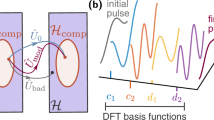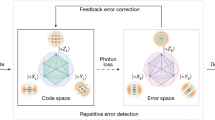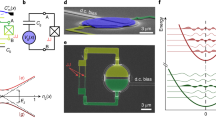Abstract
Full manipulation of a quantum system requires controlled evolution generated by nonlinear interactions, which is coherent when the rate of nonlinearity is large compared with the rate of decoherence. As a result, engineered quantum systems typically rely on a bare nonlinearity much stronger than decoherence rates, and this hierarchy is usually assumed to be necessary. Here we challenge this assumption by demonstrating the universal control of a quantum system where the rate of bare nonlinear interaction is comparable to the fastest rate of decoherence. We introduce a noise-resilient protocol for the universal quantum control of a nearly harmonic oscillator that takes advantage of an in situ enhanced nonlinearity instead of harnessing a bare nonlinearity. Our experiment consists of a high-quality-factor microwave cavity with weak dispersive coupling to a superconducting qubit with much lower quality. By using strong drives to temporarily excite the oscillator, we realize an amplified three-wave-mixing interaction, achieving typical operation speeds over an order of magnitude faster than expected from the bare dispersive coupling. Our demonstrations include the preparation of a single-photon state with high fidelity, the generation of squeezed vacuum with large intracavity squeezing and measurement-free preparation of logical states for the binomial and Gottesman–Kitaev–Preskill quantum error-correcting codes.
This is a preview of subscription content, access via your institution
Access options
Access Nature and 54 other Nature Portfolio journals
Get Nature+, our best-value online-access subscription
$29.99 / 30 days
cancel any time
Subscribe to this journal
Receive 12 print issues and online access
$209.00 per year
only $17.42 per issue
Buy this article
- Purchase on Springer Link
- Instant access to full article PDF
Prices may be subject to local taxes which are calculated during checkout



Similar content being viewed by others
Data availability
The data that support the findings of this study are available from the corresponding authors upon reasonable request.
Code availability
The code used for gate and pulse optimization is available via GitHub at https://github.com/alec-eickbusch/ECD_control.
References
Zurek, W. H. Decoherence, einselection, and the quantum origins of the classical. Rev. Mod. Phys. 75, 715–775 (2003).
Haroche, S. Nobel lecture: controlling photons in a box and exploring the quantum to classical boundary. Rev. Mod. Phys. 85, 1083–1102 (2013).
Chu, Y. et al. Quantum acoustics with superconducting qubits. Science 358, 199–202 (2017).
Burkard, G., Gullans, M. J., Mi, X. & Petta, J. R. Superconductor–semiconductor hybrid-circuit quantum electrodynamics. Nat. Rev. Phys. 2, 129–140 (2020).
Blais, A., Grimsmo, A. L., Girvin, S. M. & Wallraff, A. Circuit quantum electrodynamics. Rev. Mod. Phys. 93, 025005 (2021).
Satzinger, K. J. et al. Quantum control of surface acoustic-wave phonons. Nature 563, 661–665 (2018).
Arrangoiz-Arriola, P. et al. Resolving the energy levels of a nanomechanical oscillator. Nature 571, 537–540 (2019).
Koolstra, G., Yang, G. & Schuster, D. I. Coupling a single electron on superfluid helium to a superconducting resonator. Nat. Commun. 10, 5323 (2019).
Cortiñas, R. et al. Laser trapping of circular rydberg atoms. Phys. Rev. Lett. 124, 123201 (2020).
Chakram, S. et al. Seamless high-Q microwave cavities for multimode circuit quantum electrodynamics. Phys. Rev. Lett. 127, 107701 (2021).
Leghtas, Z. et al. Deterministic protocol for mapping a qubit to coherent state superpositions in a cavity. Phys. Rev. A 87, 042315 (2013).
Krastanov, S. et al. Universal control of an oscillator with dispersive coupling to a qubit. Phys. Rev. A 92, 040303 (2015).
Heeres, R. W. et al. Cavity state manipulation using photon-number selective phase gates. Phys. Rev. Lett. 115, 137002 (2015).
Fösel, T., Krastanov, S., Marquardt, F. & Jiang, L. Efficient cavity control with SNAP gates. Preprint at https://arxiv.org/abs/2004.14256 (2020).
Kudra, M. et al. Robust preparation of Wigner-negative states with optimized SNAP-displacement sequences. PRX Quantum 3, 030301 (2022).
Wang, W. et al. Converting quasiclassical states into arbitrary Fock state superpositions in a superconducting circuit. Phys. Rev. Lett. 118, 223604 (2017).
Khaneja, N., Reiss, T., Kehlet, C., Schulte-Herbrüggen, T. & Glaser, S. J. Optimal control of coupled spin dynamics: design of NMR pulse sequences by gradient ascent algorithms. J. Magn. Reson. 172, 296–305 (2005).
Heeres, R. W. et al. Implementing a universal gate set on a logical qubit encoded in an oscillator. Nat. Commun. 8, 94 (2017).
Reinhold, P. Controlling Error-Correctable Bosonic Qubits. PhD thesis, Yale Univ. (2019).
Ma, W.-L. et al. Quantum control of bosonic modes with superconducting circuits. Sci. Bull. 66, 1789–1805 (2021).
Roy, A. & Devoret, M. Introduction to parametric amplification of quantum signals with Josephson circuits. C. R. Phys. 17, 740–755 (2016).
Aspelmeyer, M., Kippenberg, T. J. & Marquardt, F. Cavity optomechanics. Rev. Mod. Phys. 86, 1391–1452 (2014).
Murch, K. W. et al. Cavity-assisted quantum bath engineering. Phys. Rev. Lett. 109, 183602 (2012).
Pechal, M. et al. Microwave-controlled generation of shaped single photons in circuit quantum electrodynamics. Phys. Rev. X 4, 041010 (2014).
Eddins, A. et al. Stroboscopic qubit measurement with squeezed illumination. Phys. Rev. Lett. 120, 040505 (2018).
Rosenblum, S. et al. A CNOT gate between multiphoton qubits encoded in two cavities. Nat. Commun. 9, 652 (2018).
Rosenblum, S. et al. Fault-tolerant detection of a quantum error. Science 361, 266–270 (2018).
Touzard, S. et al. Gated conditional displacement readout of superconducting qubits. Phys. Rev. Lett. 122, 080502 (2019).
Campagne-Ibarcq, P. et al. Quantum error correction of a qubit encoded in grid states of an oscillator. Nature 584, 368–372 (2020).
Elder, S. S. et al. High-fidelity measurement of qubits encoded in multilevel superconducting circuits. Phys. Rev. X 10, 011001 (2020).
Vrajitoarea, A., Huang, Z., Groszkowski, P., Koch, J. & Houck, A. A. Quantum control of an oscillator using a stimulated Josephson nonlinearity. Nat. Phys. 16, 211–217 (2020).
Reagor, M. et al. Quantum memory with millisecond coherence in circuit QED. Phys. Rev. B 94, 014506 (2016).
Flühmann, C. & Home, J. P. Direct characteristic-function tomography of quantum states of the trapped-ion motional oscillator. Phys. Rev. Lett. 125, 043602 (2020).
Flühmann, C. et al. Encoding a qubit in a trapped-ion mechanical oscillator. Nature 566, 513–517 (2019).
Sivak, V. V. et al. Model-free quantum control with reinforcement learning. Phys. Rev. X 12, 011059 (2022).
Baum, Y. et al. Experimental deep reinforcement learning for error-robust gate-set design on a superconducting quantum computer. PRX Quantum 2, 040324 (2021).
Niepce, D., Burnett, J. J., Kudra, M., Cole, J. H. & Bylander, J. Stability of superconducting resonators: motional narrowing and the role of Landau-Zener driving of two-level defects. Sci. Adv. 7, eabh0462 (2021).
Backes, K. M. et al. A quantum enhanced search for dark matter axions. Nature 590, 238–242 (2021).
Dassonneville, R. et al. Dissipative stabilization of squeezing beyond 3 dB in a microwave mode. PRX Quantum 2, 020323 (2021).
Hastrup, J., Park, K., Filip, R. & Andersen, U. L. Unconditional preparation of squeezed vacuum from Rabi interactions. Phys. Rev. Lett. 126, 153602 (2021).
Duivenvoorden, K., Terhal, B. M. & Weigand, D. Single-mode displacement sensor. Phys. Rev. A 95, 012305 (2017).
Michael, M. H. et al. New class of quantum error-correcting codes for a bosonic mode. Phys. Rev. X 6, 031006 (2016).
Gottesman, D., Kitaev, A. & Preskill, J. Encoding a qubit in an oscillator. Phys. Rev. A 64, 012310 (2001).
Noh, K., Albert, V. V. & Jiang, L. Quantum capacity bounds of Gaussian thermal loss channels and achievable rates with Gottesman-Kitaev-Preskill codes. IEEE Trans. Inf. Theory 65, 2563–2582 (2019).
Royer, B., Singh, S. & Girvin, S. M. Stabilization of finite-energy Gottesman-Kitaev-Preskill states. Phys. Rev. Lett. 125, 260509 (2020).
Axline, C. J. et al. On-demand quantum state transfer and entanglement between remote microwave cavity memories. Nat. Phys. 14, 705–710 (2018).
Hu, L. et al. Quantum error correction and universal gate set operation on a binomial bosonic logical qubit. Nat. Phys. 15, 503–508 (2019).
Gertler, J. M. et al. Protecting a bosonic qubit with autonomous quantum error correction. Nature 590, 243–248 (2021).
Burkhart, L. D. et al. Error-detected state transfer and entanglement in a superconducting quantum network. PRX Quantum 2, 030321 (2021).
Hastrup, J., Park, K., Brask, J. B., Filip, R. & Andersen, U. L. Measurement-free preparation of grid states. npj Quantum Inf. 7, 17 (2021).
de Neeve, B., Nguyen, T.-L., Behrle, T. & Home, J. P. Error correction of a logical grid state qubit by dissipative pumping. Nat. Phys. 18, 296–300 (2022).
Grimsmo, A. L. & Puri, S. Quantum error correction with the Gottesman-Kitaev-Preskill code. PRX Quantum 2, 020101 (2021).
Vuillot, C., Asasi, H., Wang, Y., Pryadko, L. P. & Terhal, B. M. Quantum error correction with the toric Gottesman-Kitaev-Preskill code. Phys. Rev. A 99, 032344 (2019).
Noh, K., Chamberland, C. & Brandão, F. G. Low-overhead fault-tolerant quantum error correction with the surface-GKP code. PRX Quantum 3, 010315 (2022).
Lingenfelter, A., Roberts, D. & Clerk, A. A. Unconditional Fock state generation using arbitrarily weak photonic nonlinearities. Sci. Adv. 7, eabj1916 (2021).
Haljan, P. C., Brickman, K.-A., Deslauriers, L., Lee, P. J. & Monroe, C. Spin-dependent forces on trapped ions for phase-stable quantum gates and entangled states of spin and motion. Phys. Rev. Lett. 94, 153602 (2005).
Albert, V. V. et al. Performance and structure of single-mode bosonic codes. Phys. Rev. A 97, 032346 (2018).
Romanenko, A. et al. Three-dimensional superconducting resonators at T < 20 mK with photon lifetimes up to τ = 2 s. Phys. Rev. Appl. 13, 034032 (2020).
Ball, H. et al. Software tools for quantum control: improving quantum computer performance through noise and error suppression. Quantum Sci. Technol. 6, 044011 (2021).
Lloyd, S. & Braunstein, S. L. Quantum computation over continuous variables. Phys. Rev. Lett. 82, 1784–1787 (1999).
Braunstein, S. L. & van Loock, P. Quantum information with continuous variables. Rev. Mod. Phys. 77, 513–577 (2005).
D’Alessandro, D. Introduction to Quantum Control and Dynamics (CRC Press, 2007).
Park, K., Marek, P. & Filip, R. Qubit-mediated deterministic nonlinear gates for quantum oscillators. Sci. Rep. 7, 11536 (2017).
Park, K., Marek, P. & Filip, R. Deterministic nonlinear phase gates induced by a single qubit. New J. Phys. 20, 053022 (2018).
Acknowledgements
We thank N. Frattini, R. Cortiñas, C. Flühmann and X. Xiao for helpful discussions. We are grateful to J. Curtis and B. Kalfus for technical assistance and I. Tsioutsios and L. Frunzio for device fabrication assistance. We thank M. Hays, B. Brock, J. Teoh, C. Wang, A. Maiti, P. Campagne-Ibarcq, S. Touzard and S. Rosenblum for helpful feedback. This research was sponsored by the Army Research Office (ARO) under grant nos. W911NF-18-1-0212, W911NF-16-1-0349 and W911NF-18-1-0020 and by the Air Force Office of Scientific Research under grant no. FA9550-19-1-0399. The views and conclusions contained in this document are those of the authors and should not be interpreted as representing the official policies, either expressed or implied, of the Army Research Office (ARO) or the US Government. The US Government is authorized to reproduce and distribute reprints for Government purposes notwithstanding any copyright notation herein.
Author information
Authors and Affiliations
Contributions
A.E., S.S.E., M.H.D. and R.J.S. developed the large displacement control method. A.E., S.R.J., V.S. and A.Z.D. implemented the numerical ECD parameter optimization. A.E., V.S. and A.Z.D. conducted the measurements. A.E., B.R., V.S. and S.M.G. developed the theory. J.V. and A.E. performed the numerical analysis of the strongly driven nonlinear oscillator. A.E. and M.H.D. wrote the manuscript with feedback from all the authors.
Corresponding authors
Ethics declarations
Competing interests
R.J.S. and M.H.D. are founders and R.J.S. is a shareholder of Quantum Circuits. The remaining authors declare no competing interests.
Peer review
Peer review information
Nature Physics thanks Christian Andersen and the other, anonymous, reviewer(s) for their contribution to the peer review of this work.
Additional information
Publisher’s note Springer Nature remains neutral with regard to jurisdictional claims in published maps and institutional affiliations.
Supplementary information
Supplementary Information
Supplementary Figs. 1–12, Sections 1–10 and Tables 1–3.
Rights and permissions
Springer Nature or its licensor holds exclusive rights to this article under a publishing agreement with the author(s) or other rightsholder(s); author self-archiving of the accepted manuscript version of this article is solely governed by the terms of such publishing agreement and applicable law.
About this article
Cite this article
Eickbusch, A., Sivak, V., Ding, A.Z. et al. Fast universal control of an oscillator with weak dispersive coupling to a qubit. Nat. Phys. 18, 1464–1469 (2022). https://doi.org/10.1038/s41567-022-01776-9
Received:
Accepted:
Published:
Issue Date:
DOI: https://doi.org/10.1038/s41567-022-01776-9
This article is cited by
-
Quantum control of a cat qubit with bit-flip times exceeding ten seconds
Nature (2024)
-
Universal control of a bosonic mode via drive-activated native cubic interactions
Nature Communications (2024)
-
Real-time quantum error correction beyond break-even
Nature (2023)
-
High-fidelity parametric beamsplitting with a parity-protected converter
Nature Communications (2023)
-
Cloaking a qubit in a cavity
Nature Communications (2023)



